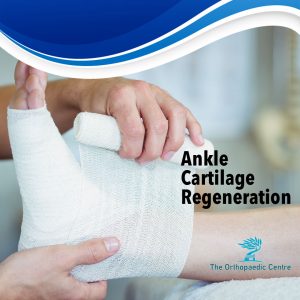Cartilage damage in the ankle is a common problem that can cause pain, stiffness, swelling, and decreased range of motion. Cartilage is a tough, rubbery tissue that lines the ends of bones and helps to cushion and protect them. When cartilage is damaged, it can lead to the development of osteoarthritis, a degenerative joint disease that can cause further pain and disability.

Image: doctoranywhere.com
There are a number of different ways to treat cartilage damage in the ankle, depending on the severity of the damage. In some cases, conservative treatment measures such as rest, ice, compression, and elevation may be enough to relieve pain and inflammation. In other cases, more invasive treatments such as surgery may be necessary.
Nonsurgical Treatment Options
There are a number of nonsurgical treatment options available for cartilage damage in the ankle. These options include:
- Rest: Resting the injured ankle can help to reduce pain and inflammation.
- Ice: Applying ice to the injured ankle can help to reduce pain and swelling.
- Compression: Wrapping the injured ankle with an elastic bandage can help to reduce swelling.
- Elevation: Elevating the injured ankle above the level of the heart can help to reduce swelling.
- Pain relievers: Over-the-counter pain relievers such as ibuprofen or naproxen can help to relieve pain.
- Physical therapy: Physical therapy can help to improve range of motion and strength in the injured ankle.
- Braces or supports: Braces or supports can help to stabilize the injured ankle and prevent further damage.
Surgical Treatment Options
In some cases, surgery may be necessary to treat cartilage damage in the ankle. Surgical options include:
- Arthroscopy: Arthroscopy is a minimally invasive surgical procedure that allows the surgeon to view the inside of the ankle joint and repair any damage.
- Microfracture: Microfracture is a surgical procedure that involves creating tiny holes in the damaged cartilage. This allows blood to clot and form a new layer of cartilage.
- Osteochondral autograft transplantation: Osteochondral autograft transplantation is a surgical procedure that involves transplanting healthy cartilage from another part of the body to the damaged area of the ankle.
- Osteochondral allograft transplantation: Osteochondral allograft transplantation is a surgical procedure that involves transplanting healthy cartilage from a cadaver to the damaged area of the ankle.
Recovery from Cartilage Damage Surgery
Recovery from cartilage damage surgery can take several months. During this time, it is important to follow your doctor’s instructions carefully and to attend all physical therapy appointments. You may need to use crutches or a walker for a period of time, and you may experience some pain and swelling. However, with proper care, most people are able to make a full recovery from cartilage damage surgery.

Image: toc.com.sg
How To Fix Cartilage Damage In Ankle
Preventing Cartilage Damage in the Ankle
There are a number of things you can do to help prevent cartilage damage in the ankle, including:
- Wearing proper footwear: Wearing shoes that fit well and provide good support can help to prevent ankle injuries.
- Avoiding high-impact activities: Activities such as running and jumping can put stress on the ankle joint, which can lead to cartilage damage.
- Maintaining a healthy weight: Excess weight can put stress on the ankle joint, which can lead to cartilage damage.
- Strengthening the muscles around the ankle: Strong ankle muscles can help to stabilize the joint and prevent injuries.
Cartilage damage in the ankle can be a painful and debilitating condition, but there are a number of treatment options available. Nonsurgical treatment options can often relieve pain and inflammation and improve range of motion. In some cases, surgery may be necessary to repair the damaged cartilage. With proper care, most people are able to make a full recovery from cartilage damage surgery.